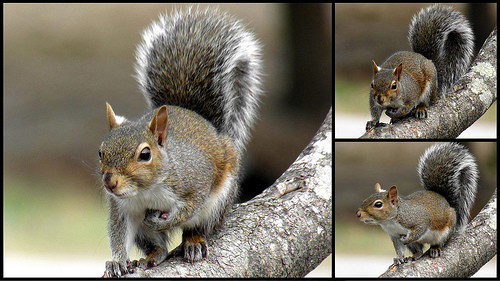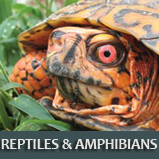See: All wildlife entries; Wildlife overview; Beaver; Black Bear; Bobcat; Northern Flying Squirrel; Cougar; Coyote; Fox Squirrel; Gray Fox; Gray Squirrel; Mink; Muskrat; Raccoon; Red Fox; Red Wolf; Southern Flying Squirrel; Striped Skunk; White-tailed Deer; Wild Boar
Wildlife profiles by region: Coastal Plain; Piedmont; Mountains; Vegetation by region

Native to North Carolina, white-tailed deer are an integral part of the state's history and modern culture, being "every man's big game animal." The male deer (buck) has long been a symbol of power and speed, and the female (doe) figures prominently in ancient legends as the embodiment of grace and beauty. Native Americans depended on the white-tail for meat and a number of important artifacts. European settlers continued this tradition of harvesting deer for survival articles; from famous residents such as Daniel Boone to the most obscure, frontier men and women wore "buckskins." White settlers also opened a commercial trade in deer hides for internal and overseas ventures.
Partially due to strict regulation of hunting, elimination of wild predators, and increased cultivation of food, the white-tailed population has recovered from earlier declines to reach an all-time high. North Carolina's herd is estimated at between 1.5-2 million, approximately 10 percent of the national total. In many areas deer numbers have risen along with human development to the point that many residents are calling for increased hunting seasons and higher bag limits.
Two species of wildcats live in North Carolina. The cougar or mountain lion-a large, unspotted cat with tawny-colored fur and a long tail-though not widespread, is occasionally seen in the southern Appalachian Mountains and the coastal swamps, possibly due more to the releasing of pet cougars than to any significant wild population. The bobcat is the only short-tailed cat indigenous to the mid-Atlantic region. Smaller and having a spotted coat, this solitary and secretive hunter of rodents and rabbits appears in most parts of the state.
The black bear (Ursus americanus) is the only species of bear found in North Carolina. It originated in North America and is the most adaptable member of the bear family with a very wide range. In North Carolina, black bears are found from the Coastal Plain into the Appalachian Mountains, with the greatest concentration in the Great Smoky Mountains National Park region along the North Carolina-Tennessee border. While some North Carolina counties still allow the hunting of bears, it is estimated that during the 1990s about one-third of the bears killed in southern Appalachia were taken illegally and often sold to Asian markets.
Between 1900 and 1920 red wolves were extirpated from most of the eastern portion of their range, including North Carolina, and by 1980 they were determined to be extinct in the wild. The red wolf was first reintroduced in the United States in 1987, when four pairs were released into Dare County's 120,000-acre Alligator River National Wildlife Refuge. Additional releases were made, and the first reproduction in the wild occurred in 1988. By the late 1990s there were approximately 50 red wolves living in the Alligator River refuge and nearby Pocosin Lakes National Wildlife Refuge. These wolves help control North Carolina's exploding white-tailed deer populations, also keeping them healthy by preying on the weak and ensuring that only the stronger animals survive to reproduce.
All 16 species of bats found in North Carolina eat insects, from mosquitoes and moths to beetles, crickets, and flies. Even the smallest species eat a lot of insects; some experts believe that a healthy bat colony, rather than anything manmade, is the best way to keep the mosquito population down. Some bats also eat crop-destroying pests. As the public has become more aware of the helpful nature of bats, measures have been started to preserve their numbers. At Chimney Rock Park, several caves in which bats roost have been permanently closed to the public. Bat boxes (artificial roosts) are becoming a common sight in some neighborhoods around the state.
Twenty-nine species of whales are known to inhabit the coastal waters of North Carolina. They are divided into two groups: the order Mysticeti, or baleen whales, and the order Odontoceti, or toothed whales. Baleen whales are distinguished by the large strips of whalebone, or baleen, that hang down from their upper jaws, which they use to eat. Six species of baleen whales frequent the state's coastal waters: the minke whale, Bryde's whale, sei whale, fin whale, black right whale, and humpback whale.
Toothed whales have teeth instead of baleen in their mouths and one blow hole as opposed to the baleen's two. Because of their teeth, members of the order Odontoceti are able to prey upon much larger marine animals than the baleen whales can. Toothed whales found in North Carolina waters include the false killer whale, killer whale, long-finned pilot whale, short-finned pilot whale, melon-headed whale, goose-beaked whale, True's beaked whale, dense-beaked whale, Gervais' beaked whale, dwarf sperm whale, pygmy sperm whale, and sperm whale. Dolphins and porpoises are also considered to be toothed whales. Species found off North Carolina include the harbor porpoise, bridled spotted dolphin, Atlantic spotted dolphin, striped dolphin, Atlantic white-sided dolphin, saddle-backed dolphin, and bottle-nosed dolphin.
North Carolina has many other thriving mammals, including rabbits, raccoons, opossums, beavers, and chipmunks. Foxes, both red and gray, live throughout the state. Wild boars (Sus scrofa), not present in the United States before 1890, were introduced into North Carolina at Hooper's Bald in Graham County in 1912, when George Moore of the Whiting Manufacturing Company imported 14 boars from Germany and Russia to join other exotic animals on a large, fenced tract he intended to develop as a game preserve. By the early 1920s, the population had multiplied and many boars had escaped from the preserve; over the next quarter-century wild boars became well established in modern-day Nantahala National Forest and its environs.
Perhaps the most unusual mammal in North Carolina is the flying squirrel. A web of thin, furry skin on both sides of the body extending from the foreleg to the hindleg permits it to perform acrobatic feats. Although the flying squirrel is still fairly common in the state, it is rarely seen because it is nocturnal, resting by day and foraging for food, principally nuts and seed, by night.
Learn more about North Carolina's:


